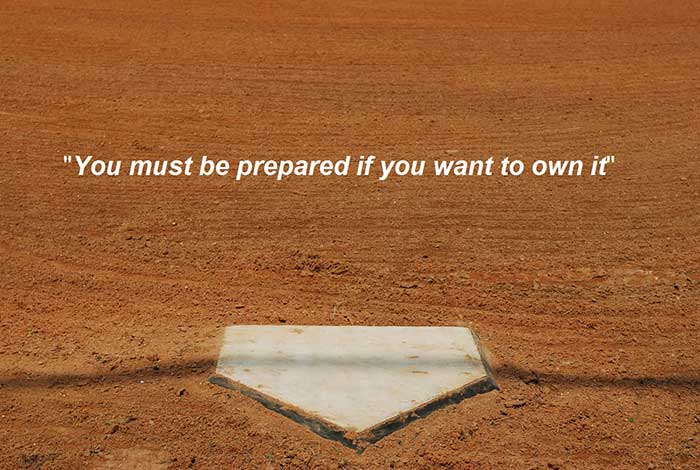The Best Hitters in the World Fail 70% of the Time – WRONG!

How many times have you heard:
“The game of baseball is a game of failure – even the best hitters fail 70% percent of the time.”

This statement is wrong and factually untrue yet most believe it because you’ve been told it over and over. That belief alone already puts you in a negative mental state before you ever get to the plate. What you need to understand is that just because you didn’t get a hit to get on base you didn’t fail as a batter.
If you hit the ball and it’s a ground out or a fly out that’s not a failure – you did what you were supposed to do –put the ball in play. Here’s an example. You hit a screaming line drive and the third baseman happens to react quickly, dives to his left and makes an incredible catch. At the end of the day it goes in the books as an out and against your batting average. Did you fail? No. You hit the ball. Hitting in itself is a difficult task. Hitting a round ball (that’s curving or dropping with varying speeds) with a round bat and have about .5 to .7 seconds to do it in – CONGRATS – that ain’t easy. So never get upset for hitting the ball no matter what the outcome.
So what are some fundamental things you can do as a hitter to break the brainwashing that hitting is mostly failure and the mental preparation and strategies to become a better hitter? We start by getting the correct mind set and mental approach. Here is a quick look at three basic things you should begin with.
#1: Mind Set – Hitting actually has a 75-82% SUCCESS rate
The average strike out percentage since 1980 for college and pro players ranges between 18-25% (fangraphs.com). Therefore the average hitter actually only “fails” 18-25% of the time so that’s a success rate of 75-82%! I include walks and HBP as success also. Your primary purpose as a batter is to hit the ball. Once you hit the ball you have no control over the fielders and if they can get to the ball or even field it correctly – it’s out of your hands. Again, plain and simple – your primary job as a batter is to put the ball in play.
So now you see factually that hitting the ball actually has a high success rate – never forget that. There is too much emphasis that successful hitting is only measured by base hits and home runs. Say you go 0-3 in a game. You hit the ball every time hard but two were ground outs and one fly out. Most batters would be disappointed. You shouldn’t be – you hit the ball. You controlled what you could control. Remember, once you hit the ball it’s out of your hands.
#2 Control – You can only control YOU
You can control you – that’s it. You can’t control an ump’s strike zone (or bad calls), the weather, the pitches thrown, the fielders skill level, field conditions, obnoxious fans, etc.
You can control your at-bat. Strive to get what many coaches keep track of – a Quality At
Bat (QAB). A QAB can be simply defined as:
An at bat in which the batter is productive in a way that fits the situation, whether that involves advancing the runner with a sacrifice bunt or even a ground ball out, getting on base, or making the pitcher throw a lot of pitches. (http://en.wikipedia.org/wiki/Glossary_of_baseball_(Q))
Ask your coach how they “grade” or “define” a QAB.
#3 Preparation – The QAB
There are many steps to prepare for a QAB. Here are a few important ones:
- Ask your coach for their QAB Sheet. Many coaches keep track of things likehow many pitches the batter had the pitcher throw (usually it’s 8+ pitches), did you get a base hit, did you get an RBI, sac bunt, bunt for a base hit, move a runner over, Walk/ HBP/ Sac Fly, hit-and-run, hard fly ball, hard ground ball, etc.. This will help you understand what you as a batter need to do to have success at the plate.
- Work on your hitting mechanics every day. Tee work, soft toss, cage work etc. Get to the point where you have proper strong hitting mechanics. No one is perfect all the time but you at least want to have 80% of your mechanics down. You have enough to think about at the plate – you don’t want to be thinking about your swing too. Your swing should become automatic. That comes with practice and repetition.
- Know your weakness and strength at the plate. Where is your “hot zone” – the area you know you can hit the ball. Know your “weak zone” – where even though it might be a strike, you seem to have trouble with it. No one is hot in the entire strike zone. So when you know where your hot zone is you know when a pitch is thrown there you attack. Sounds simple but many batters don’t really know where their true hot and weak zones are.
- Watch the pitcher warming up and while your teammates are at bat. Is he a Lefty or Righty? What is the pitchers best pitch, what does he seem to throw when he’s ahead in the count, what does he throw when behind in the count, when a base runner is on base, does he take more time before he throws a certain pitch, does he seem to “grind” his hand in his glove when he is getting a grip for a certain pitch, does he have a different arm angle for certain pitches, etc.
- Go to the plate with the thought you are swinging at every pitch. What I mean is you decide not to swing rather than to swing. You don’t realize it but most of you reading this already do this – but no one has verbalized it to you. Look, just before the pitcher releases the ball you begin your load to initiate your swing – therefore you ARE thinking “I am swinging.” After the ball leaves his hand you “analyze” whether to continue the swing process or not. If you wait until the ball has left the pitchers hand to initiate your swing and decide to swing – you rarely will hit the ball because you will be late.
- Assess where the fielders are defensively while you’re at the plate. Simple example would be let’s say you’re a right handed batter yet the outfield is shaded toward right field or the infield is shifted more toward first base. Odds are the pitcher is going to throw pitches on the outside of the plate. Therefore you have a pretty good idea you’re going to get a steady diet of outside pitches.
- Short memory. You can’t change the past so get over it. Learn from it but move on. This is tough. We are all usually tougher on ourselves than anyone else. That little voice in your head is with you 24hrs a day and it will start making you doubt yourself and your confidence will decline. Once you start losing confidence, your performance declines. If you strike out 3 or 4 times in a row it would be easy to get down on yourself. I suggest you look at it differently. The odds are greatly in your favor that you will succeed the next time (remember the 75-82%?) so get psyched to get back up there and hit.
Once you have a firm grasp on these first principles you can tackle the more “Advanced” strategies. Things like knowing if the pitch count is in your favor or not (tips off the type of pitch you’ll probably see), having a plan at the plate, knowing the situation and a few more – but that’s for another article.
No matter what situation you find yourself in, above all, your primary goal is just to put the ball in play – the one thing you can control. Plus NEVER forget, you have at least a 70%+ success rate at the plate so go up there with confidence every time.


This is a fantastic perspective to keep as a hitter, and to promote as a coach. Excellent post!
Great post, great perspective to keep in mind. I especially like the tip, go to the plate thinking you are going to swing at every pitch.. very insightful.
Excellent post, I enjoyed reading all of these insightful tips. Maybe add more about the mental aspects of the game and more about how a hitter needs to be mentally ready
Makes so much sense. If every hitter applied this, they will be successful. Confidence, good mind set, and aggressiveness will make a good hitter into a great hitter. Has helped me plenty and it keeps on proving it works
In most situations at the plate, when not called upon to bunt, hit and run, or just sacrifice, I used to say this message over and over again, ‘C’mon pitch, throw your best pitch because I’m going to rip it’….that was a time when I owned the pitcher and was asked in so many post game comments, ‘how in the hell can you hit the ball so well, all of the time?’….I can’t remember the times that I would strike out, so I must not have, right?… ‘How can you hit the ball so well when you have 2 strikes in your count…? my answer was simple: my first swing I go for downtown, my second swing is to drive the gaps, my third swing is to just put the ball into play somewhere.’ and that was as simple as that, never worried about who the pitcher is, his record, etc., just ‘mind over matter’….I’m gonna hit your best pitch, and with that mind set, seldom did it fail….that skill was all developed after starting at SS for my four college game years.